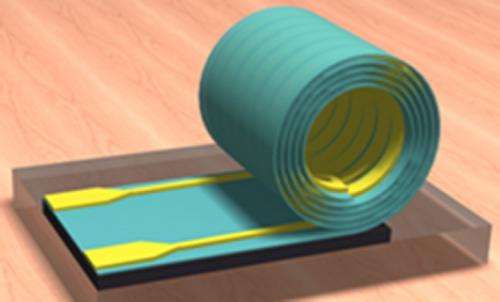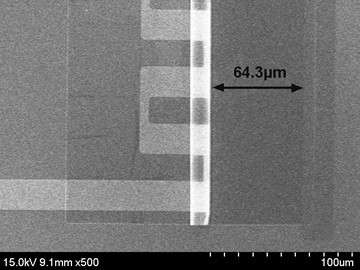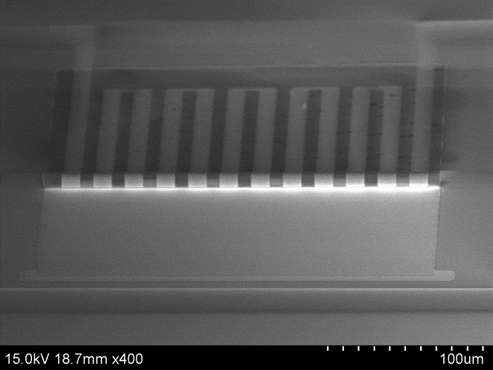December 12, 2012 feature
Self-rolled tubes make miniature electronics

(Phys.org)—With downscaling as one of the main pursuits in electronics research today, scientists and engineers are developing a variety of miniaturization strategies, from those involving powerful microscopes to self-assembly methods. In a new study, a team of engineers has developed a way to miniaturize spiral inductors that are often used in radio frequency integrated circuits (RFICs) by patterning inductor cells onto a flat, strained nanomembrane that rolls itself up into a tube. In the proposed design, miniature inductors could be less than 1% of the size of conventional inductors while offering an improved performance.
The engineers, led by Xiuling Li, Associate Professor in the Department of Electrical and Computer Engineering at the University of Illinois in Urbana, Illinois, have published their paper on a design and prototype of self-rolled inductors in a recent issue of Nano Letters.
"Self-rolled-up nanotechnology is a platform my research group has been working on for several years," Li told Phys.org. "We have made significant progress in several aspects of the rolling-up process control and mechanism understanding, and have been looking for killer applications. I think we might have just found one. Preliminary experimental results are consistent with the simulations."
Inductors, which are devices that store energy in their magnetic fields, are commonly used in RFICs. As Li explained, RFICs are used for both wireless and wired communication applications, from portable consumer electronics to battleground surveillance. While other components of RFICs have been steadily shrinking, inductors have not been able to scale down without suffering performance losses.
"Shrinking the size without compromising or even enhancing the performance is always desired," Li said. "Compared to the aggressive scaling of active devices (transistors), inductors have simply not been able to keep up with the pace."

On an RFIC, a typical spiral inductor takes up an area of about 400 x 400 μm2. In the new study, the researchers used their new method to design a spiral inductor with an area of 45 x 16 μm2, which is about 0.45% of the conventional one. Plus, the new inductor has a Q factor (a measure of efficiency) of 21, compared with 6 for conventional inductors (excluding the thick metal type), and is significantly better at confining its magnetic field, resulting in fewer losses.
The method the researchers used involves depositing a patterned-metal thin-film layer on a strained silicon nitride nanomembrane. Each metal strip along the rolling direction serves as an inductor cell, and all the cells are connected by metal connection lines.
Once these strained nanomembranes are released from their substrates, the energy relaxation of their initial strain causes them to roll spontaneously. Momentum generated by the relaxation causes the planar membrane to scroll up from one or both ends, and then continue to roll into a tube. By carefully designing the amount of stress in the membrane along with other factors, the engineers can control the ultimate rolled-up size of the final tube. One of these rolled-up tubes acts as a spiral inductor, having a miniaturized area as noted above. Multiple inductors can then be transfer-printed and arranged at will on wafers with predesigned RFICs.
While there has traditionally been a trade-off between inductor size and performance, Li explained that the researchers could improve both aspects by using a 3D architecture fabricated through 2D processing.

"In conventional planar spiral designs, increasing the number of turns increases the inductance; however, more turns in plane means a larger footprint is required, which lead to more parasitic capacitance with the substrate, lowering the self-resonant frequency," she said. "Therefore, inductors need to go 3D. For the 3D spiral inductor design we proposed, the inductance can be readily increased without causing too much parasitic effect. As a result, the rolled-up 3D design not only reduces the footprint, but is also suitable for higher frequency applications at a much smaller area budget.
"Processing difficulties and associated cost are some of the main challenges for past 3D designs. The platform we are proposing uses a unique fabrication method where 3D architectures are fabricated through 2D planar processing. The structure only becomes 3D spontaneously when it is released from its mechanical support. No processing on curved or suspended surfaces is involved."

In the future, the researchers plan to build upon the prototype presented here and demonstrate more ideal structures experimentally. They also hope to apply the rolling technique to not just inductors, but also tube-based capacitors, resistors, filters, and transformers. All these components could then be integrated together for a "super miniaturized" RFIC platform.
More information: Wen Huang, et al. "On-Chip Inductors with Self-Rolled-Up SiNx Nanomembrane Tubes: A Novel Design Platform for Extreme Miniaturization." Nano Letters. DOI: 10.1021/nl303395d
Journal information: Nano Letters
Copyright 2012 Phys.org
All rights reserved. This material may not be published, broadcast, rewritten or redistributed in whole or part without the express written permission of Phys.org.


















